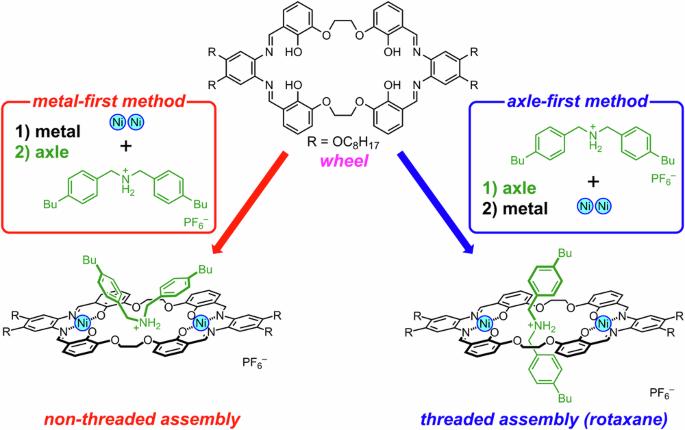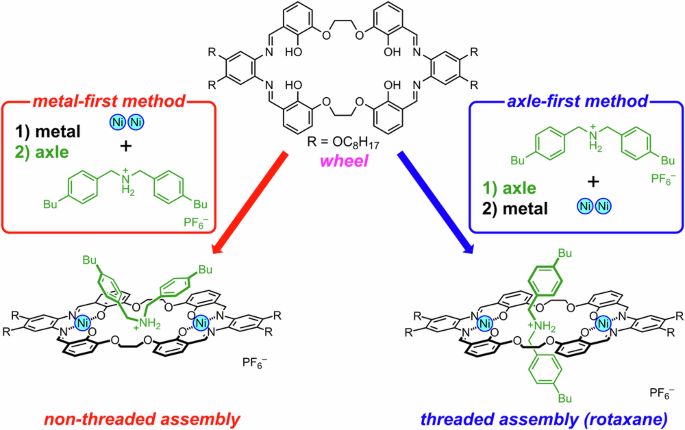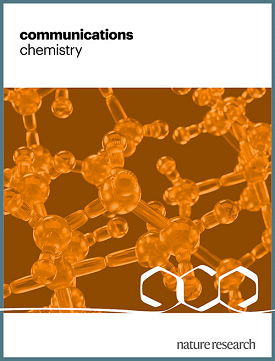由二镍(II)金属环和二苄基铵轮轴组成的无螺纹轮轴组件和轮轴型螺纹轮轴组件。
IF 5.9
2区 化学
Q1 CHEMISTRY, MULTIDISCIPLINARY
引用次数: 0
摘要
轮烷的制备通常使用共价键将一个车轮部件捕获到一个车轴分子上,而仅使用非共价相互作用的轮烷型车轴装配的研究则少得多。在这里,我们展示了一种二镍钴金属环与二苄基铵轴分子仅通过非共价相互作用就能形成两种不同类型的轮轴组装体。无螺纹组装是通过在与轴分子络合之前将 Ni2+ 引入大环(金属优先法)获得的。无螺纹组装体与溶液中的各组分迅速达到平衡。在非金属轮和车轴分子形成假大环之后,通过引入 Ni2+(车轴先行法)获得了螺纹组装体。尽管螺纹组装体仅通过非共价相互作用来维持,但它与解离的物种并不平衡。因此,无螺纹和有螺纹轮轴组装体中的一种比另一种更容易形成是由组装途径决定的。本文章由计算机程序翻译,如有差异,请以英文原文为准。


Non-threaded and rotaxane-type threaded wheel–axle assemblies consisting of dinickel(II) metallomacrocycle and dibenzylammonium axle
Rotaxanes are typically prepared using covalent bonds to trap a wheel component onto an axle molecule, and rotaxane-type wheel–axle assembly using only noncovalent interactions has been far less explored. Here we show that a dinickel(II) metallomacrocycle forms two different types of wheel–axle assemblies with a dibenzylammonium axle molecule based only on noncovalent interactions. The non-threaded assembly was obtained by introduction of Ni2+ into the macrocycle before the complexation with the axle molecule (metal-first method). The non-threaded assembly was in rapid equilibrium with each of the components in solution. The threaded assembly was obtained by introduction of Ni2+ after the formation of a pseudorotaxane from the non-metalated wheel and the axle molecule (axle-first method). The threaded assembly was not in equilibrium with the dissociated species even though it was maintained only by noncovalent interactions. Thus, formation of one of the non-threaded and threaded wheel–axle assemblies over the other is governed by the assembly pathway. Mechanically interlocked rotaxanes are typically prepared using covalent bonds to trap a wheel component onto an axle molecule, and rotaxane-type wheel–axle assembly using only noncovalent interactions has been far less explored. Here, a dinickel(II) metallomacrocycle is found to form two different types of wheel–axle assemblies, with a dibenzylammonium axle molecule forming both non-threaded and rotaxane-type threaded assemblies, based only on noncovalent interactions, with formation of one over the other governed by the assembly pathway.
求助全文
通过发布文献求助,成功后即可免费获取论文全文。
去求助
来源期刊

Communications Chemistry
Chemistry-General Chemistry
CiteScore
7.70
自引率
1.70%
发文量
146
审稿时长
13 weeks
期刊介绍:
Communications Chemistry is an open access journal from Nature Research publishing high-quality research, reviews and commentary in all areas of the chemical sciences. Research papers published by the journal represent significant advances bringing new chemical insight to a specialized area of research. We also aim to provide a community forum for issues of importance to all chemists, regardless of sub-discipline.
 求助内容:
求助内容: 应助结果提醒方式:
应助结果提醒方式:


